This article first appeared in the May/Jun 2015 issue of WGM.
Cotai 2.0 is coming, but can it be the saviour of the Macau gaming industry? With stock prices plummeting by close to 50 percent since January 2014, will the dramatic increase in supply of integrated resorts, starting from 27 May this year when Galaxy Phase II and Broadway open their doors, stop the rot? Or will it exacerbate the problem by increasing supply without the added demand to service it? WGM explores what’s coming over the next few years, with eight new properties due to open, and the issues each face.

In 20, 30 or even 50 years’ time, future generations will look back at the history of Macau and pinpoint 2015 as a key moment in its evolution. But will it be the moment that sparked Macau’s second great gaming boom or the one that saw the glory days come spectacularly crashing down?
Right now the jury is out. After more than a decade of record gaming revenues that saw this unique city not only surpass Las Vegas as the world’s gaming epicentre but leave it spluttering in its wake, Macau’s annual revenue fell last year for the first time since 2001.
The first few months of 2015 haven’t been any better, with drops of around 50 percent year on year reported each and every month.
There are a number of reasons for this, the most telling being the Chinese Central Government’s anti-corruption crackdown for which there is no clear end in sight, yet in the midst of the chaos comes the dawn of a new era in Cotai where an incredible eight new properties will start opening their doors from 27 May this year.
The irony is that these shiny new integrated resorts were planned and construction started while Macau was still soaring ever upwards – their success considered such a certainty that no expense was spared in their design or jaw-dropping features. Now, rather than popping the Champagne bottles when Galaxy becomes the first of the eight to open its new doors, the entire gaming community is keeping a quiet and tentative eye on proceedings – hoping rather than expecting it will get things motoring again.

For sure, this is a strange time. Should the six concessionaires be fearful or excited?
Right now they must feel like they’re being attacked from all sides. While China’s crackdown has scared off a huge chunk of the VIP market that was once Macau’s cash cow, the Macau SAR Government has been throwing its own punches including a ban on smoking in casinos and a firm refusal to budge on issues such as the allocation of new gaming tables.
Macau’s cap on gaming tables has been an issue for some time now with the government having previously declared a maximum three percent compound annual growth on the total number allowed for 10 years from 2013 to 2022.
The concessionaires clearly paid scant regard to that criteria in designing their new properties in Cotai, most simply assuming it would be thrown out the window once Cotai 2.0 became a reality. Instead, the government has become increasingly emphatic in its claims that the cap will remain and the reality of that scenario is an ugly one for casino operators.
Based on the official figure of 5,711 gaming tables in operation at the end of 2014, just 171 new allocations will be allowed this year. The three properties that will open – Galaxy II, Broadway and Melco Crown’s Studio City – have budgeted for roughly 900 between them.
Jump ahead to 2016 and the numbers say only 177 more tables should hit the market but The Parisian, Wynn Palace, MGM Cotai and Louis XIII want 1,500 tables.

Even if the government counts ahead as they have hinted they may do – basically allocating every allowable new table up to 2022 immediately – the 1,525 tables it adds up to falls well short of the roughly 3,150 the eight Cotai properties want.
And what of the labor shortage? Macau’s strict regulations prohibit foreigners from working at gaming tables but with more than 50,000 new workers required by 2017 and an unemployment rate of just 1.7 percent – roughly 6,700 unemployed people – there could be an estimated shortfall of 13,800 workers in those restricted positions depending upon how many new tables are ultimately allocated.
This all paints quite a bleak picture, but it needn’t be that way.
The Chinese Central Government has made it clear that one of the reasons for their crackdown is to encourage Macau to reduce its excessive reliance on gaming and expand its non-gaming attractions so it becomes more attractive as a genuine tourist destination. Following suit, Macau’s government has since made it known that table allocations for each property will be based on their non-gaming attractions.
This should be seen as a tremendous opportunity by the casino operators to appeal to a much wider audience than they have previously and it bodes well that most recognized the growing importance of this sector when designing their new Cotai resorts – even if some have done it better than others. Their next crucial step will be promoting themselves to the world.
“The challenge is that results are not immediate in creating or developing new markets to Macau,” explained Glenn McCartney, Assistant Professor in Gaming & Hospitality Management at the University of Macau. “Naturally the integrated resorts and the Macau government will communicate several positive attributes about Macau but this must be considered on the flip side of the perceptions of Macau by regional and international tourists over the past decade.

“So some of this has to be readdressed – the hotels might introduce lower priced hotel rooms or offer special packages – but again it takes time to reverse perceptions on Macau that didn’t attract leisure travellers before. Also, other regional destinations have been pitching affordability, shopping, entertainment and events so there is a lot of competition out there.
“The new properties will face that challenge of filling non-gaming and in creating greater revenues from these facilities. It will take greater marketing innovation and working more strategically on social media platforms, for example, for greater engagement with regional and international leisure travel segments.”
While non-gaming will become an increasingly important part of Macau’s long-term future, it is also reasonable to expect the opening of so many integrated resorts to prompt some sort of boost on the gaming side from players curious to explore the arrivals. And the one area that held Macau back at its peak – not enough hotel rooms to satisfy the huge weekend demand – will be significantly eased with around 46,000 new rooms on the way.
Time will tell what sort of impact these next few years have on the local gaming landscape, but in the meantime let’s take a close look at the eight properties to comprise Cotai 2.0.
GALAXY PHASE II
The first of the new resorts to open in Cotai alongside sister property Broadway at Galaxy Macau, Galaxy Phase II has the unenviable honor of being the test case for those to follow – and rest assured all eyes will be firmly fixed in its direction over the coming months.
The first question on everyone’s lips will undoubtedly centre upon table allowance and whether or not Galaxy is allocated enough new tables to be profitable. When detailed plans of Galaxy II were first released in 2012, it included up to 500 new gaming tables but as of mid-April the Macau government had yet to decide how many would be granted with some analysts predicting a figure closer to 150 tables was more realistic.
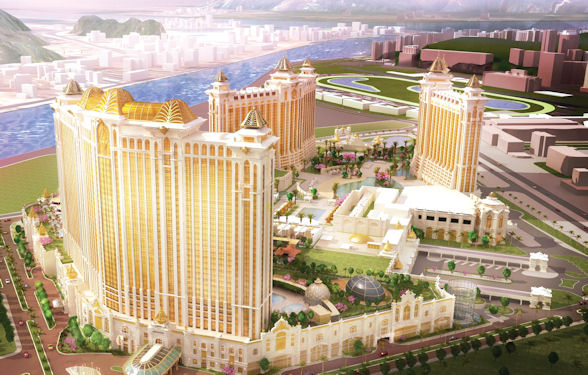
Galaxy Phase II will double the property’s size
Such a disparity would obviously impact heavily on Galaxy’s earning potential in an already difficult climate, which might explain why they have been keen to spruik Galaxy II’s non-gaming offerings.
These include two new luxury hotels, headed by the world’s first all-suite Ritz-Carlton, as well as the world’s largest JW Marriott with over 1,000 rooms. The two hotels combined will add 1,300 rooms to Galaxy’s hotel stocks, taking their total to around 3,600 rooms across five hotels.
Phase II just about doubles the size of Galaxy to around a million square meters of space with 100,000 square meters dedicated to retail. There will also be increased meeting and banquet space capable of catering for 3,000 guests, while 45 new food and beverage outlets will push the total to over 100 – the most notable being Italian fine dining restaurant 8½ Otto e Mezzo Bombana at the newly built Ritz-Carlton. 8½ Otto e Mezzo Bombana is renowned as one of Hong Kong’s top restaurants – having been awarded three Michelin stars the past four years running – and becomes just the third restaurant in Macau to boast Michelin’s top honor alongside Robuchon au Dôme and The Eight.

Families will be well catered for by the new Grand Resort Deck, which expands on Galaxy’s famous skytop wave pool. The new deck will feature the Skytop Adventure Rapids which is being touted as the world’s longest skytop aquatic adventure river at 575 metres long.
BROADWAY MACAU
Formerly known as the Grand Waldo, this property was purchased by Galaxy in July 2013 for HK$3.25 billion and has been completely refurbished ahead of its re-opening alongside Galaxy Phase 2 on 27 May. Although it’s no secret the opportunity to acquire the Grand Waldo’s 38 gaming tables was a major factor in prompting Galaxy’s purchase, its reincarnation as Broadway Macau seems to be a clear statement that the company recognizes just how important non-gaming will be if Macau is to stage a recovery.

In fact, we’re just as interested to see how Broadway performs as we are its big brother in the coming months. The first Macau property to specifically target mass market over VIP gaming, it could well serve as a blueprint of how Macau’s casinos operate in the future.
Broadway Macau is being billed as a genuine entertainment precinct and, as the name suggests, aims to recreate New York’s famous theatre district with a 3,000 seat auditorium that will host a range of local and international productions.
It will also feature a hawker-style street market with over 40 food stalls to choose from and various street performers providing music and color.

Broadway will be connected to Galaxy Macau via an air-conditioned sky bridge.
STUDIO CITY
If Macau has been guilty of neglecting all things non-gaming in the past, Melco Crown’s soon to open Studio City appears ready to make up for it in one fell swoop.
Due to open in September, this mammoth HK$25 billion project will bring Hollywood to Macau with the cinematically-themed complex expected to put on quite a show – literally. Among the multitude of attractions is a fully operational TV broadcast studio where visitors can be part of the audience and witness the filming of some of Asia’s most popular shows; The House of Magic where resident magician Franz Harary and others will show off their skills of illusion and Studio City’s entertainment center which seats 5,000 and provides a new venue for concerts, shows and sporting events.
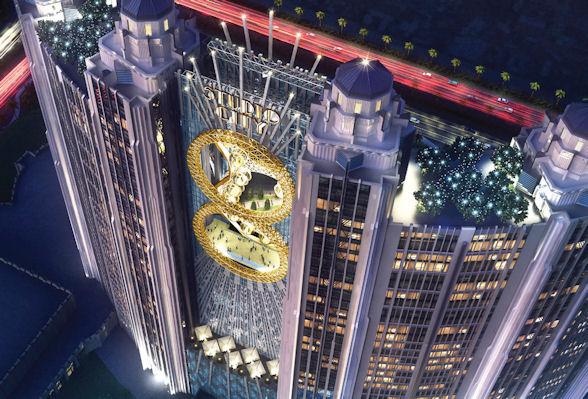
An artist’s impression of the spectacular Studio City
Macau’s nightlife is set to receive a much-needed boost with the arrival of Pacha Nightclub, while at the other end of the spectrum comes Macau’s first theme park – the 30,000 square foot Family Entertainment Center featuring characters from Warner Bros and DC Comics. The Family Entertainment Center will be home to the motion simulator ride Batman Dark Flight, allowing fans to fly through Gotham City in a unique virtual reality experience.
Without doubt though, Studio City’s star attraction will be Asia’s highest Ferris wheel, Golden Eye. Built directly into the façade of the building between its two main towers, Golden Eye sits a dizzying 130 metres above the ground and will inevitably join the likes of Macau Tower and the Grand Lisboa as icons of the local landscape.
Melco Crown have clearly adopted a strategy of something for all with Studio City – a concept reflected in the decision to split the two towers with Celebrity Tower aimed at mass market and Star Tower more premium guests. They boast 1,600 rooms between them.
Like their fellow concessionaires, Melco Crown will be sweating on their gaming table allocation. With room for 500 on the floor, CEO Lawrence Ho said in January they would begin operating with 400 tables but given recent comments from the government insisting the table cap wouldn’t be expanded beyond the current three percent compound annual growth, 400 could prove a little ambitious – maybe more than a little!

Perhaps having such a wide range of non-gaming attractions will prove to be Studio City’s winning formula.
THE PARISIAN
Originally planned to open towards the latter half of 2015, a recent construction delay has forced Sands China to push the highly anticipated arrival of The Parisian back to sometime in 2016 with an exact date yet to be set. The delay, which saw construction halted for almost three months between June and August last year, highlighted just how reliant all six concessionaires are on the whims of the Macau government as their respective openings approach.
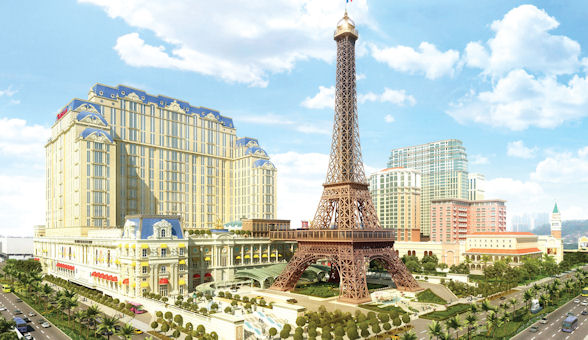
The Parisian will be a standout feature of the Cotai landscape with its scale replica of the Eiffel Tower
While the official line was that Sands China had built 10-stories of structure while holding a license that only allowed for earthworks, it has been suggested the government was also keen to stagger the opening dates of Cotai’s new properties.
Nevertheless, The Parisian remains arguably the most anticipated of all. Like its sister property the Venetian, which was the second largest building by floor space in the world when it opened in 2007, the Paris-themed integrated resort will be a monster. Among other things it promises almost 150 boutique shops and 15 restaurants over 490,000 square feet of retail space as well as another 3,000 hotel rooms – further bolstering Sands China’s reputation as pioneers in the non-gaming sector.

The Parisian’s gaming offerings will be substantial with around 450 tables if approved and an extraordinary 2,500 slot machines, but it’s hard to look past the replica Eiffel Tower already making its way skyward as the property’s main drawcard. Set to stand 165 metres high – just over half the size of the real thing – Macau’s version will include an observation deck and a restaurant located on the third floor.
WYNN PALACE
Like The Parisian, Wynn Palace has had to reassess its original opening date of early 2016 due to problems obtaining enough construction worker permits to stay on schedule. The anticipated three month delay isn’t ideal given it potentially allows some rival properties to gain a valuable headstart, but CEO Steve Wynn hasn’t wavered from his belief that Wynn Palace is the most important project in the company’s esteemed history.
Coming at a cost of HK$31 billion, it will build on Wynn’s reputation for quality with the 1,700 hotel rooms and surrounding facilities said to be even more opulent than both Wynn Macau and Wynn Las Vegas.
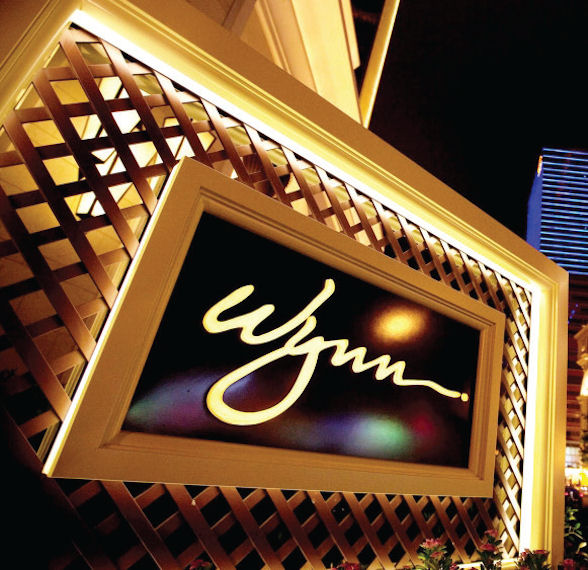
A performance lake surrounded by restaurants will grace the front of the building – borrowing once again from the concept made famous by the Bellagio in Vegas – however the property’s standout features will be its aerial transport system and its floral theming, which will see floating bouquets and flower gardens in various shapes and themes spread throughout.
The aerial transport system is a first for Macau, with small gondolas shaped as smoke-breathing dragons carrying people from the nearby light-rail station directly to the hotel. The benefits of the system may not be realized for some time though. Wynn Palace will eventually be the first stop for Macau’s new light-rail which will connect the Cotai ferry landing to properties on the Cotai Strip, but construction of the light-rail system has been nothing short of shambolic. Originally predicted to cost around HK$4 billion with a completion date of late 2011, repeated delays and route changes have seen that cost blow out to HK$16 billion with yet another new finish date of September 2017 … but even the government has admitted they really have no idea when it will open.
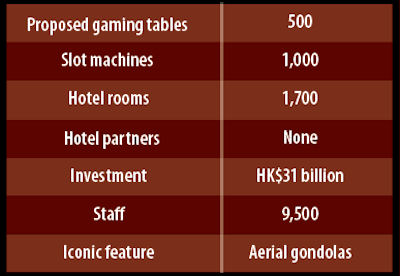
Wynn Palace promises to be a truly stunning property, but with construction issues, the light-rail disaster and ongoing uncertainty over the allocation of gaming tables there is still a long way to go before Steve Wynn can relax and enjoy his company’s latest creation.
LOUIS XIII
The most ambitious of all the properties currently under construction in Cotai would also seem to be the one at most risk from Macau’s gaming slump. With Louis XIII touted as the ultimate in uber-luxury – its best suite tipped to cost around HK$1 million per night – chairman Stephen Hung has made no secret of the fact he will be targeting wealthy Chinese VIPs to fund his extravagant creation once it opens in early to mid-2016.
But will they come? VIP customers have been the driving force behind Macau’s boom over the past 10 years so it seemed only logical to target them when the Louis XIII concept was first announced in 2013. Now, with VIPs staying away in droves due to China’s anti-corruption crackdown, the concern is that Louis XIII will become little more than an expensive white elephant.

An artist’s impression of Louis XIII
Not that Hung has been deterred, having recently confirmed the property will open as planned before the middle of 2016. While most of us will never make it through the front doors, Louis XIII remains an intriguing development due simply to the huge amount of money being poured into it. When complete, it will have just 236 rooms to show for the HK$8 billion investment although each will go for a minimum of HK$10,000 per night.
The casino will offer 66 tables with a minimum bet of HK$5,000, which seems sort of pricey until you consider the attached retail area. This select group of boutiques will be by appointment only with jewellery items starting at HK$1 million and going as high as HK$100 million.

Hung made global headlines last September when he ordered 30 Rolls Royce Phantoms in which to chauffer guests at a cost of HK$155 million – the largest single order in Rolls Royce history. And the hotel itself promises to be just as colorful as its owner with the exterior painted bright red and crowned with a giant 20-metre diamond.
MGM COTAI
There is no doubt Cotai will look very different by the time all of the current developments are complete and when it comes to aesthetics, MGM Cotai looks to be a standout. Borrowing from its MGM Macau predecessor which features three distinct segments of the building stacked one on top of the other, MGM Cotai takes the concept to another level by giving the impression of randomly stacked boxes.
Achieving this effect involved three different architectural firms working together, while around 20 interior design companies will complete the luxurious interiors.
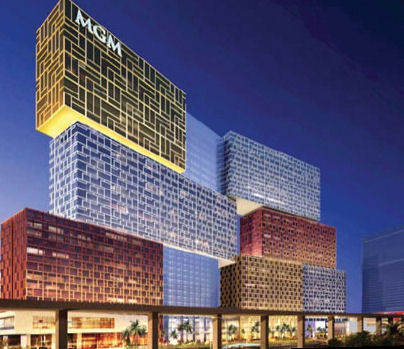
MGM Cotai’s innovative look is the result of three different architectural firms working together
With 1,600 hotel rooms and space for 500 gaming tables, MGM Cotai isn’t the biggest of the new properties but it’s certainly the most mysterious with one of its main features being a five-storey luxury mansion built inside the hotel.
Again, the concept borrows from another of their properties, MGM Grand in Las Vegas, which boasts a highly secretive hidden hotel within a hotel that even most of the staff have never seen. Macau’s version will apparently be even more high-end than its predecessor in Vegas and will include private gardens to be enjoyed by guests.
MGM Cotai will also include a number of multi-level skylofts on the top floors providing intimate surrounds and spectacular views.

Originally planned to open in early 2016, that estimate has now been revised to late 2016 due to those pesky licensing problems that have been a common theme across much of Cotai’s development.
LISBOA PALACE
The last of the six concessionaires to break ground in Cotai, SJM’s massive Lisboa Palace will certainly test their ability to adjust to the changing face of Macau. Chairman Stanley Ho almost single-handedly built Macau’s casino industry during his 40- year gaming monopoly and SJM still occupies top spot with 23 percent of market share in 2014 from the 18 properties it operates.
But with China demanding Macau’s operators diversify with less focus on gaming and more non-gaming options to attract tourists, SJM faces an unfamiliar challenge given non-gaming accounts for well under one percent of their revenue. By comparison, Sands sits around 10 percent.

Lisboa Palace will be an enormous property
This is rooted in SJM’s long history in Macau and the fact that they’ve only ever needed to focus on gaming, but now their hand is being forced. So what can we expect?
The HK$27 billion Lisboa Palace will be a huge resort when it opens in 2017, boasting three hotels with 2,000 rooms, a range of retail outlets and restaurants and, not surprisingly, space for a whopping 700 gaming tables – although it will be a while before that lofty dream is fulfilled.

While SJM have come to the non-gaming party with a grand wedding pavilion and multi-purpose theatre, it is the building’s incredible architecture – which will be produced on a grand scale with the complex itself covering seven hectares – that promises to be the most intriguing. Proclaimed as a unique cultural exchange between Europe and Macau, it was inspired by 17th and 18th Century European royal residences fused with traditional Chinese motifs.







